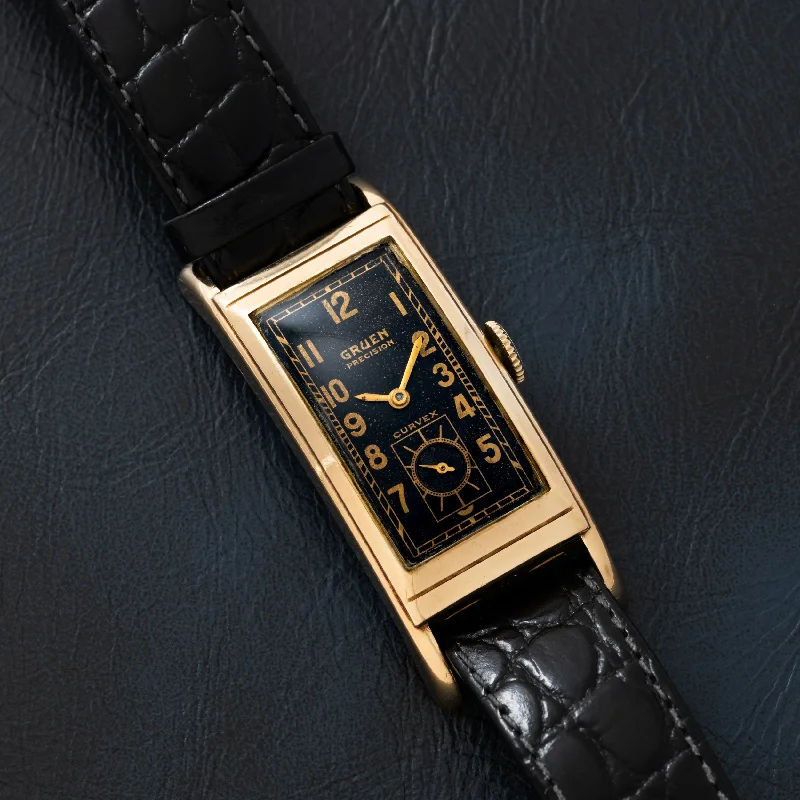The Bulova Curv, with its curved quartz movement, might have taken the watch world by storm when it was released last year.
But it was by no means the first curved wristwatch ever created.
For example, in 1916, Tissot created the “Banana” watch, with a specially curved crystal. It was made for a Russian aristocrat, who sent it back to Tissot’s headquarters for maintenance just before the outbreak of the Russian Revolution. However, it remained in Switzerland after the Revolution broke out, and served as inspiration for the Banana Centenary Edition released this year.
However, the most famous curved wristwatch is without a doubt the Gruen Curvex, which was introduced in 1935 and almost single-handedly saw Gruen through the Great Depression.
Thanks to strategic partnerships with Swiss companies like Rolex and movement manufacturer Aegler, Gruen had enjoyed success with its doctor’s watch, the Techni-Quadron (which Rolex marketed as the Prince in Europe and the British Empire). But the brand also earned a reputation for innovation in aesthetics. Throughout the 1920s, Gruen experimented with different movement and watch designs, including the Quadron, which housed a tonneau-shaped movement in a rectangular case.
But after the Wall Street Crash of 1929, the U.S. watch industry took a massive hit. Sales of watches went down from five million to only 800,000 a year. Gruen, which was once ranked in the top tier of the watch industry, found itself selling watches at lower price points.
By 1934, Gruen was forced to sell off its shares in Aegler and concentrate movement production in its Swiss facility, the Precision Factory, located in Bienne. The next year, investors and stockholders were horrified to find that the company was in debt to the tune of $1.8 million, or $36 million in today’s dollars. The Board of Directors forced Fred Gruen to resign as President of the company his father had founded, and brought in Benjamin S. Katz, president of a New York-based manufacturer of watch cases.
However, despite the economic setbacks and political changeovers, the brand was poised for a comeback—which came in the form of this watch, the Curvex.
Gruen had actually applied for a patent for a curved movement in 1929, through its Bienne-based agent, Emile Frey. It was granted to Frey in 1932, but assigned to Gruen. Accordingly, the movement designers at the Precision Factory set to work designing what would become a revolutionary watch movement: the Calibre 311.
The Calibre 311 was the world’s first curved wristwatch movement. It became so famous, and such a best-seller, that the name “curvex” became associated with the style of watch. However, since the patent was registered exclusively to Gruen, the only true “curvex” watch from the period is the Curvex.
The Curvex that we offer here is 48mm lug to lug and features the Calibre 311 and dates to 1937. Featuring a 14K gold filled case, this watch has developed a beautiful lemony tone. The dial, a dark charcoal black has patinaed evenly and beautifully. The dial is complete with gilt finishes and signed "Gruen Precision Curvex"
Without the Curvex, it’s quite possible that the brand would have gone under a lot sooner than it did. Fortunately, the sales of the watch—Gruen’s flagship—would bolster the company well into the 1950s, when the model was discontinued. Shortly after, Gruen would sell off the Precision Factory, which was eventually bought by Rolex.
The Curvex occupies a special place in the hearts of many collectors, who appreciate it for its revolutionary design.

